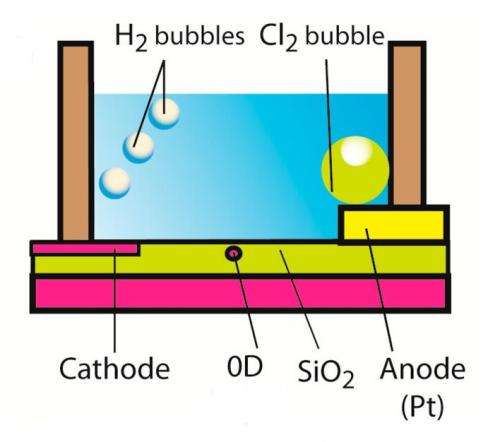August 13, 2013 feature
Zero-dimensional transistor harvests bubble energy wasted during water electrolysis

(Phys.org) —When hydrogen is produced from water during electrolysis, some energy is lost as tiny bubbles. In a new study, researchers have demonstrated that 25-nm transistors—so small that they're considered zero-dimensional (0D)—can be used to transform this lost energy into electric pulses. Millions of these 0D transistors could be used to detect individual bubbles and generate electric pulses at an optimal efficiency, gathering part of the energy lost during electrolysis and making it available for other uses.
The researchers, Nicolas Clément at CNRS in Villeneuve d'Ascq, France, and his coauthors, have published their paper on using 0D transistors to harvest energy from bubbles in a recent issue of Nano Letters.
As one of the most promising approaches for producing hydrogen as a fuel source, electrolysis involves applying an electric current to water to separate the oxygen and hydrogen atoms. During electrolysis, gas bubbles are formed, causing some energy loss.
"All the mechanisms of energy loss during electrolysis are not fully understood," Clément told Phys.org. "Such a device, combined with high-precision cameras, may improve understanding in the future. Sources of energy loss are either diffusion of hydrogen in water or movement of counterions around electrodes during bubble emission."
To demonstrate how 0D transistors can recover some of this energy, the researchers placed a 0.2-microliter droplet of salt water in a microbath. Underneath, they placed a transistor and two electrodes. Under an applied voltage, relatively small (18-24-?m) hydrogen bubbles were emitted at the cathode, while larger chlorine bubbles were emitted at the anode. Increasing the voltage resulted in an increase in the bubble emission frequency.
The 0D transistors could detect individual bubbles, and bubble size could be evaluated by analyzing changes in current. By detecting the bubbles, the transistors transformed the bubble energy into electrical pulses. In theory, 2 million 0D transistors could fit below the microbath, which results in an output pulse power of 500 ?W and a pulse power efficiency of about 99%.
"There are three novelties," Clément said. "First, we use a 0D transistor in liquid whereas researchers have previously focused on 2D or 1D transistors (such as nanowires). Second, we show that we can detect electrically single bubbles, which is of great importance for electrochemists to understand and optimize electrochemical processes. Third, we show that we gather energy lost to generate electrical pulses at optimum efficiency. Historically, some researchers have tried to gather part of energy lost during hydrogen production by using a rotary apparatus (several patents can be found). Here we propose a new way."
The ability to detect tiny bubbles and convert them into electric pulses could have a variety of applications, such as lab-on-chip devices for hydrogen storage. Another potential application is in physiology, since the electric signal has a similar amplitude as that of the action potential in a neuron. Here, the system could be used as an artificial action potential generator to perform local neuron stimulation with tunable amplitude and frequency.
In the future, the researchers plan to demonstrate other applications with 0D transistors and better understand their behavior in liquid.
More information: N. Clément, et al. "Water Electrolysis and Energy Harvesting with Zero-Dimensional Ion-Sensitive Field-Effect Transistors." Nano Letters. DOI: 10.1021/nl4019879
Journal information: Nano Letters
© 2013 Phys.org. All rights reserved.



















